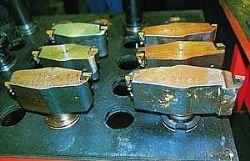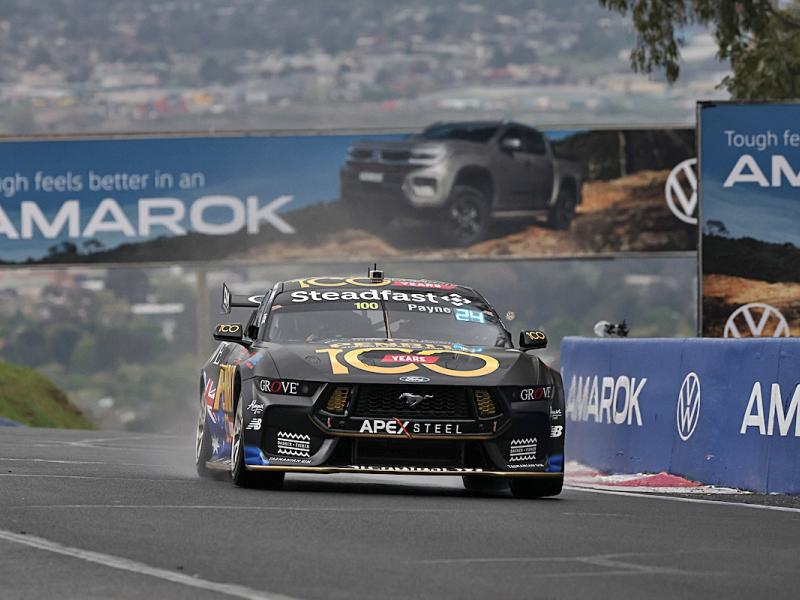Small-part manufacturing using Swiss tooling is a rapidly growing industry sector. More and more automotive repairers are users of small tools because of the growing role of electronics and hydraulics for control-units and mechanisms. A growing number of various small components are machined, though the parts are of much smaller dimensions than those made generally in the engineering industry. Usually made from bar stock in sliding head machines, the components machined with Swiss tools are in the diameter-range of 0.5 to 32 mm, with 5 to 20 mm being the most common. With components being small, the machining zone in sliding-head CNC-automatics is a lot more cramped than in many other machine tools. Tools have to be small and access to adjust and change tooling is limited. Cutting tools are often placed in gangs or on turrets so as to be able to machine close to the spindle collet as well as to minimize the tool change time. Demands from machine shops employing sliding head machines, and even older automatics, are increasing for improved tools and methods in order to stay competitive. A lot of manufacturers have been suppliers in other areas of machining and when investing in a sliding-head CNC-lathe, find that in many cases there seems to have been a considerable difference in the tool-technology levels available. Other issues include tool-life predictability and satisfactory chip control for unattended machining, where operators are responsible for several enclosed CNC-lathes and rely on the cutting tool condition, thus avoiding extra tool changes that will disrupt production. Accessibility to maintain cutting tools in the machine and the time taken to change cutting edges are important in Swiss machining as cutting times are short and thus have a bigger influence on throughput times of high-volume production. “The right tooling is a critical factor for modern CNC-machines to perform satisfactorily in that batch machining can be optimized as regards cycle times and predictable tool-lives,” explains Geoffrey Bryant, managing director of NC Engineering in Watford, UK, distributors of Citizen sliding head machines. “Modern tools can also provide added flexibility as they are capable of various operations, needing only the material and program to be changed for the machine.” Tooling developments for Swiss machining The new rhombic-shaped, 35-degree angle inserts (VCEX) in the CoroTurn range are periphery-ground and have a long 4-degree angled flat. These have very close (E) tolerances for finishing and super-finishing operations with a broad cutting depth range, down to 0.03 mm. As such they can be used for combination cuts of roughing and finishing, as well as cuts that require good surface finish (e.g. Ra 0.3 microns), involving turning, facing and back-cutting. In addition to F-geometries, the mirror-like finish of these inserts facilitate good chip flow. A sharp cutting edge, edge radii down to zero, modern cermet and coated insert grades provide the means for generating more exact small component shapes, accuracy and finish. General purpose CorTurn 107 inserts (with G- and M- insert tolerances), make up a very extensive ISO-insert shape program for Swiss machining. These include dedicated roughing, medium-duty and finishing geometries in the latest coated carbide and cermet insert grades. These provide modern, high levels of performance and results for a very broad range of turning operations The Wiper geometry provides an important means to achieve combinations of higher feeds and improved surface finish. Developed by Sandvik Coromant originally, by allowing the feed rate to be doubled, Wiper inserts can reduce machining times dramatically, down to half, and improve surface finish and chip control. New developments in parting and grooving are frequently occurring operations in Swiss machining and have for many years been performed with tools that are not part of a modern sliding-head machine. Now there are high-performance solutions for this area within the CoroCut program. This is a specially developed tool to meet the criteria of current sliding head machines: such as allowing easy insert indexing in cramped spaces and the need for maximum cut-off length. The built-in stability of the tool holder and insert combination allows turning to widen grooves, etc. and, in so doing, helps to keep the number of needed tool types down. Also here, high accuracy machining has been taken into account with a precision-insert version (GF) as well as an all-round version (CM). The development of the CoroCut concept continues. Sandvik Coromant brought out the very first indexable insert parting tool in the 1970s and have led the way in this area with Q-Cut and CoroCut. CoroCut 3 is the next stage in this development and very much suited for Swiss machining with its minimal parting widths of one mm. Developed for versatility in the shallow parting of tubes and bars as well as groove-cutting, it provides increased productivity, material savings, ease of maintenance and high security. The insert is – different to other CoroCut tooling – mounted tangentially with a centre screw, giving insert indexing precison. The concept of tangentially mounted inserts is not new of course but in CoroCut 3, it is put to use at a new technology level. The result of internal machining operations are to a great extent dependent upon the quality of the boring bar, insert geometry, setting accuracy of tool and the tool clamping in the machine. CoroTurn boring bars provide high levels of accessibility as well as stability. Many years of boring bar development and the consideration of needs in sliding head machines has been included in the design. Complemented by EasyFix tool-holding sleeves, which ensure easy setting of the centre height, as well as providing excellent tool holding stability, here is a combination of features which ensure that no link in the chain to achieve successful internal machining is left to chance. CoroTurn 111 tools have added positive geometries which make them especially suitable for internal operations where vibration tendencies occur. With boring bar diameters down to 5 mm, Swiss-machining applications which are cutting force sensitive can be optimized with these tools. Many demanding operations, due to tool overhang and tough materials can be solved and improved with CoroTurn 111 inserts. Another frequently occurring turning-area in Swiss machining which is being adapted to modern indexable insert technology is that of threading. The U-Lock system for threading has a large programme of insert-types and threads as well as a unique Tailor made service. Holders have now been developed to suit Swiss machining and to provide users with the advantages the system has provided the general turning area for many years. For milling and drilling in turning centres performing Swiss-type machining with driven tools, CoroMill and CoroDrill concepts are especially suitable to cope with the demands for reliable high-performance production. Indexable insert endmill concepts in the form of the 390-type cutters for larger-diameter tooling have a proven performance in multi-task machines as well as machining centres. They provide smooth, versatile machining for a large range of applications. Complemented by smaller-diameter solid carbide tooling, in the form of CoroMill Plura endmills and CoroDrill Delta C drills, with the latest developments in tool geometry and grades, most materials and operations can be tackled with improved machining speeds and results.
Cutting tool developments for Small Part Machining
Cutting tool developments for Small Part Machining
Motorsport
Wednesday, 04 February 2009






